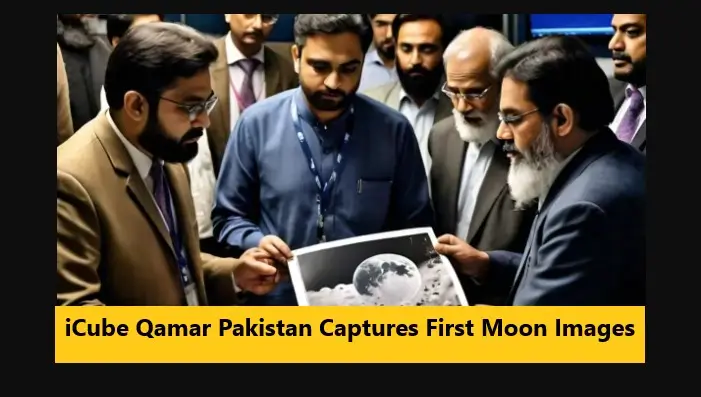iCube Qamar Pakistan Captures First Moon Images.
Pakistan’s iCube Qamar Captures First Lunar Image, Marking Historic Milestone
Pakistan’s space program has taken a giant leap forward with the successful transmission of the first image from its lunar satellite, iCube Qamar.
This historic achievement comes after the satellite completed three orbits around the moon, marking a significant milestone in the country’s space exploration endeavors.
Read More: Pakistan’s first moon mission Reach lunar orbit: ICUBE-Q
Launched just days ago on May 3rd aboard China’s Chang’e-6 mission, iCube Qamar swiftly entered lunar orbit on May 8th, as confirmed by the Pakistan Space and Upper Atmosphere Research Commission (SUPARCO).
Equipped with a sophisticated dual-camera system, the satellite is beaming back captivating images of the moon’s surface from a distance of approximately 200 kilometers.
This mission holds immense significance for Pakistan, as iCube Qamar represents the culmination of dedicated efforts by the Institute of Space Technology (IST) in collaboration with China’s Shanghai University SJTU and SUPARCO.
The satellite itself is a marvel of miniaturization, built to the CubeSat standard.
What are CubeSats and Why are They Important?
CubeSats are a revolutionary development in space exploration, offering a compact, standardized design that allows for a multitude of scientific and educational applications.
These miniature satellites adhere to specific size constraints, typically taking the form of a cube with modular components.
Their lightweight nature, often weighing only a few kilograms, makes them ideal for a variety of space deployment purposes.
The primary function of CubeSats is to democratize space exploration by facilitating:
- Scientific Research: CubeSats offer a cost-effective platform for conducting groundbreaking research in space, allowing scientists to study lunar and celestial phenomena, gather valuable data, and test new technologies.
- Technology Development: CubeSats serve as a valuable testing ground for innovative space technologies, enabling researchers to validate concepts and pave the way for future advancements in areas like propulsion, communication systems, and miniaturized scientific instruments.
- Educational Initiatives: By offering a relatively inexpensive entry point into space exploration, CubeSats empower universities and research institutions to engage students in real-world space projects, fostering a new generation of space scientists and engineers.
The applications of CubeSats are vast, encompassing a wide range of missions such as:
- Earth Observation: CubeSats can be used to monitor Earth’s climate, track environmental changes, and gather valuable data for agricultural and resource management purposes.
- Remote Sensing: CubeSats equipped with specialized sensors can collect high-resolution imagery of the Earth’s surface, providing valuable insights for geological surveys, disaster response, and urban planning.
- Atmospheric Research: CubeSats deployed in low Earth orbit can gather crucial data on atmospheric composition, helping us understand weather patterns and climate change.
- Communications: CubeSats offer the potential for establishing low-cost communication networks in space, enabling data relay and expanding our reach in the cosmos.
- Astronomy: CubeSats can be used to conduct astronomical observations from unique vantage points, contributing to our understanding of the universe.
- Technology Demonstration: CubeSats provide a platform for testing new space technologies in a real-world environment, accelerating innovation and paving the way for future space missions.
With the successful transmission of its first lunar image, iCube Qamar marks a new chapter for Pakistan’s space program. This mission not only contributes to scientific discovery but also serves as a testament to the country’s growing capabilities in space exploration. As iCube Qamar continues its lunar odyssey, the world eagerly awaits further groundbreaking discoveries from this remarkable satellite.
Note: The information above might not be accepted 100%. Please verify from your own sources. We will not be responsible for any kind of loss due to our content.
For more news, please visit Munafa Marketing.




